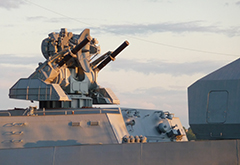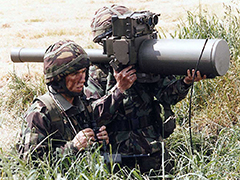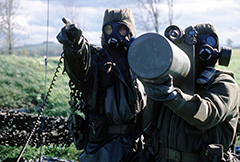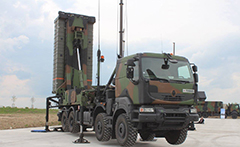23. S-200 Missile System:
The NPO Almaz S-200 Angara/Vega/Dubna, NATO reporting name SA-5 Gammon (initially Tallinn), is a very long range, medium-to-high altitude surface-to-air missile (SAM) system designed in the 1960s to defend large areas from bomber attack or other strategic aircraft. Each battalion has 6 single-rail missile launchers for the 10.8 m (35 ft) long missiles and a fire control radar. It can be linked to other, longer-range radar systems. The S-200 surface-to-air missile system was designed for the defense of the most important administrative, industrial and military installations from all types of air attack. More details
24. Bristol Bloodhound Missile:
The Bristol Bloodhound is a British surface-to-air missile developed during the 1950s. It served as the UK's main air defence weapon into the 1990s and was in large-scale service with the Royal Air Force (RAF) and the forces of four other countries. Part of sweeping changes to the UK's defence posture, the Bloodhound was intended to protect the RAF's V bomber bases to preserve the deterrent force, attacking bombers that made it past the Lightning interceptor force. Bloodhound Mk. I entered service in December 1958, the first British guided weapon to enter full operational service. More details
25. Javelin Surface to Air Missile:
Javelin is a British man-portable surface-to-air missile, formerly used by the British Army and Canadian Army. It can be fired from the shoulder, or from a dedicated launcher known as Javelin LML: Lightweight Multiple Launcher. Capable of being vehicle mounted, the LML carries three rounds. It was replaced in front line British service by the Javelin S-15, sold commercially as the Starburst surface-to-air missile in 1993 (radio frequency guided Javelin was retained for some time thereafter for training purposes), and later by the Starstreak starting around 1997. The Javelin GL was hastily purchased by the Canadian Forces to replace the existing Blowpipe surface-to-air missile system that failed last-minute tests during preparations for the deployment to the Gulf. More details
26. Blowpipe Missile:
The Shorts Blowpipe is a man-portable surface-to-air missile that was in use with the British Army and Royal Marines from 1975. It was superseded by an interim design, Javelin, and later the greatly improved Starstreak. The missile is supplied as a single round in a storage cylinder/firing tube. The aiming unit is clipped to the launch tube and fired from the operator's shoulder. To reduce the overall size of the container, the rear fins of the missile are stored in the larger diameter cylinder at the front of the tube (this also contains the Yagi antenna for transmitting guidance signals); during firing, the fins slip onto the rear of the missile as it flies through and are held there by heat-activated adhesive tapes. More details
27. NASAMS:
NASAMS (National/Norwegian Advanced Surface to Air Missile System) is a distributed and networked medium to long range air-defence system. NASAMS was the first surface-based application for the AIM-120 AMRAAM (Advanced Medium Range Air-to-Air Missile). The missile itself is named SLAMRAAM (Surface Launched AMRAAM). NASAMS 2 is an upgraded version of the NASAMS air-defence system and it has been operational since 2007. The Norwegian company Kongsberg Defence & Aerospace teamed up with Raytheon and initiated the NASAMS programme as a cooperative effort for the Royal Norwegian Air Force. More details
28. Barak 8 Missile:
Barak 8 also known as LR-SAM or as MR-SAM is an Indo-Israeli surface-to-air missile (SAM), designed to defend against any type of airborne threat including aircraft, helicopters, anti-ship missiles, and UAVs as well as ballistic missiles, cruise missiles and combat jets. Both maritime and land-based variants of the system exist. Barak 8 was jointly developed by Israel Aerospace Industries (IAI), India's Defence Research & Development Organisation (DRDO), Israel's Administration for the Development of Weapons and Technological Infrastructure, Elta Systems, Rafael and other companies. Bharat Dynamics Limited (BDL) produces the missiles. More details
29. SAMP/T Defense System:
SAMP/T is a theater-level air defense system designed for point defense against current and future airborne threats. One of only a handful of European-produced systems that can counter ballistic missiles, SAMP/T is developed by Eurosam and jointly owned by MBDA Missile Systems and Thales. The system is fielded by Italy and France to protect against UAVs, cruise missiles, short-range ballistic missiles ranging up to 600 km, and fighter aircraft. System components include a command and control vehicle, Arabal radar, and up to six transporter erector launcher (TEL) vehicles, each equipped with eight Aster interceptors and a supply of reload missiles. More details
30. Boeing YAL-1 Airborne Laser:
The Boeing YAL-1 Airborne Laser Testbed (formerly Airborne Laser) weapons system was a megawatt-class chemical oxygen iodine laser (COIL) mounted inside a modified Boeing 747-400F. It was primarily designed as a missile defense system to destroy tactical ballistic missiles (TBMs) while in boost phase. The aircraft was designated YAL-1A in 2004 by the U.S. Department of Defense. The YAL-1 with a low-power laser was test-fired in flight at an airborne target in 2007. A high-energy laser was used to intercept a test target in January 2010, and the following month, successfully destroyed two test missiles. Funding for the program was cut in 2010 and the program was canceled in December 2011. More details










